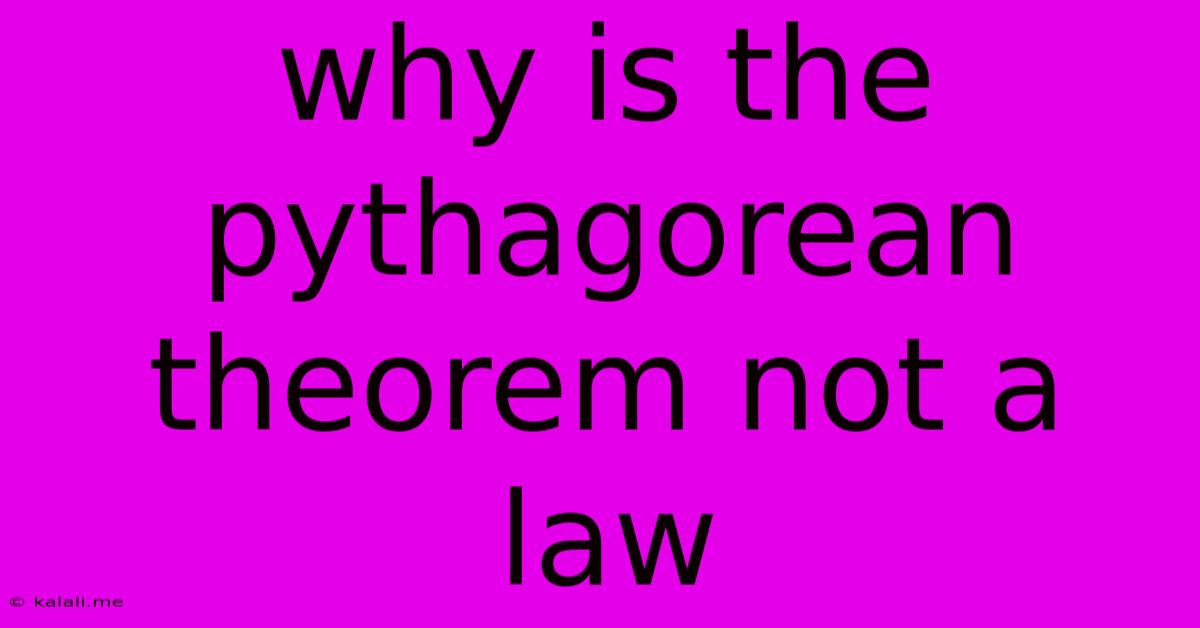Why Is The Pythagorean Theorem Not A Law
Kalali
May 23, 2025 · 3 min read

Table of Contents
Why the Pythagorean Theorem Isn't a Law: Understanding the Difference Between Theorems and Laws
The Pythagorean theorem, a cornerstone of geometry, is often mistakenly referred to as a law. This article clarifies the distinction between theorems and laws in the context of mathematics and science, explaining why the Pythagorean theorem, despite its profound importance, remains a theorem, not a law. Understanding this difference is crucial for grasping the fundamental nature of mathematical and scientific knowledge.
The Pythagorean theorem states that in a right-angled triangle, the square of the hypotenuse (the side opposite the right angle) is equal to the sum of the squares of the other two sides. This relationship, expressed as a² + b² = c², holds true for all right-angled triangles, regardless of their size or orientation. Its applications are vast, spanning fields from construction and surveying to advanced physics and computer graphics.
However, despite its widespread applicability and undeniable truth within its defined scope, the Pythagorean theorem is not a law of nature. So, what's the difference?
The Nature of Theorems and Laws
Theorems are statements that have been proven true based on previously established axioms, definitions, and other theorems. They are logical consequences derived within a specific mathematical system. The Pythagorean theorem, for instance, is proven using deductive reasoning within the framework of Euclidean geometry. Its truth is established through mathematical proof, not through observation or experimentation.
Laws, on the other hand, are descriptive generalizations about the behavior of the natural world. They are based on empirical observations and experiments, summarizing consistent patterns in nature. Laws are subject to revision or refinement as new evidence emerges. Newton's Law of Universal Gravitation, for example, is a law because it describes a fundamental force observed in the universe. While extremely accurate in many situations, it has been refined and superseded by Einstein's theory of General Relativity in certain contexts.
Key Differences Summarized:
- Origin: Theorems originate from mathematical axioms and logical deduction; laws originate from empirical observation and experimentation.
- Scope: Theorems are true within a specific mathematical system; laws describe patterns observed in the natural world.
- Verification: Theorems are proven through logical arguments; laws are supported by evidence but are never definitively proven.
- Revision: Theorems are unchanging within their defined system; laws can be refined or replaced by more accurate descriptions as new data becomes available.
The Pythagorean theorem, being a proven mathematical statement within the framework of Euclidean geometry, perfectly fits the definition of a theorem. It doesn't describe a physical phenomenon or a pattern observed in nature; it's a logical consequence within a mathematical system. While it has practical applications in understanding physical phenomena, it remains fundamentally a mathematical concept.
Beyond Euclidean Geometry: Exploring Limitations
It's important to note that the Pythagorean theorem's applicability is limited to Euclidean geometry—the familiar geometry we experience in everyday life. In non-Euclidean geometries, such as those found in curved spaces (like the surface of a sphere), the theorem does not hold. This further underscores its nature as a theorem dependent on the underlying assumptions of its mathematical framework.
In conclusion, the Pythagorean theorem is a powerful and elegant theorem, a cornerstone of geometry. However, its fundamental nature as a mathematical statement derived from logical deduction distinguishes it from scientific laws that describe observable patterns in the natural world. The clarity of this distinction is vital for a nuanced understanding of both mathematics and the scientific method.
Latest Posts
Latest Posts
-
What Does A Bad Spark Plug Look Like
May 23, 2025
-
Does An Air Pump Give Co2
May 23, 2025
-
How Many Ounces Of Cheese In A Cup
May 23, 2025
-
How To Take Off A Broken Screw
May 23, 2025
-
How To Get Gasoline Smell Off Hands
May 23, 2025
Related Post
Thank you for visiting our website which covers about Why Is The Pythagorean Theorem Not A Law . We hope the information provided has been useful to you. Feel free to contact us if you have any questions or need further assistance. See you next time and don't miss to bookmark.